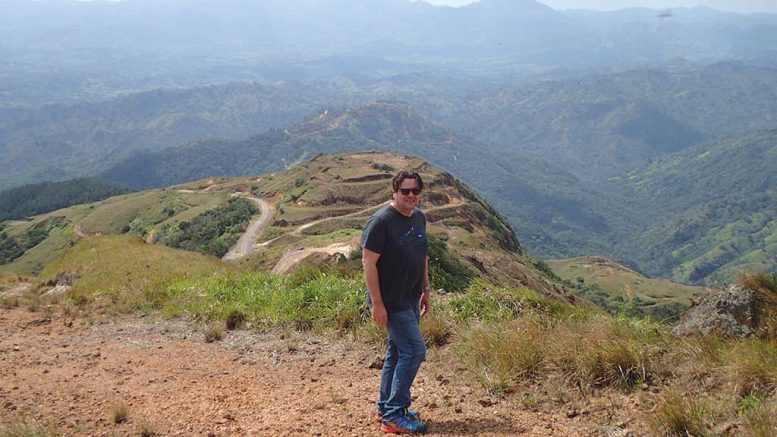As president and CEO of Grayd Resource, geologist Marc Prefontaine and his team discovered the La India gold deposit, 200 km east of Hermosillo in Sonora, Mexico, selling it to Agnico Eagle Mines (TSX: AEM; NYSE: AEM) in 2011 for $275 million. Agnico put the open-pit mine into commercial production two years later.
Today Prefontaine and the same technical team — now at Orla Mining (TSXV: OLA) — are banking on similar success in Panama at the junior’s Cerro Quema gold project.
Orla Mining acquired Cerro Quema through its recent merger with Pershimco Resources, and Prefontaine says the Panamanian project offers significant exploration potential.
Not only will the oxide resources at Cerro Quema support a low-cost heap-leach mine, Prefontaine says, but the property gives Orla a chance to explore for copper-gold targets.

Senior consulting geologists Stan Myer and Fletcher Bourke lecturing investors,
analysts and executives about the Cerro Quema project. Credit: Orla Mining.
“Cerro Quema is similar to La India,” Prefontaine says in an interview. “They’re both high-sulphidation, epithermal gold systems. They’re pretty specialized epithermal systems, and when you can get the oxides they make nice, low-capex, 0.7 to 0.8 gram gold per tonne, open-pit heap leach deposits.
“The attractiveness for us of looking for those systems are the low capital costs involved in construction — you’re looking at $100 million to $150 million, as opposed to a porphyry that can be in the order of hundreds of millions, into the billions.”
A prefeasibility study Pershimco completed on the project in 2014 outlined two oxide pits — La Pava and Quema — that would produce half a million ounces of gold over a five-year mine life (552,000 oz. in 23.9 million tonnes grading 0.72 gram gold per tonne in the measured and indicated category).
“We went down to look at it and saw 550,000 oxide ounces with a prefeasibility that works well,” Prefontaine says. “We saw there had not been any systematic exploration on the property since the late 1990s, and felt there was tremendous exploration upside to increase the oxide. The goal is to get a resource out and indicate that you could have at least 100,000 oz. a year for 10 years.”
Orla Mining also boasts Pierre Lassonde as its largest shareholder. The chairman of Franco-Nevada (TSX: FNV; NYSE: FNV) has a 12.3% stake in the junior and should help the company raise money quickly and easily, Prefontaine says, adding that “the Lassonde factor brings tremendous access to the capital markets.”
Lassonde is already familiar with Panama through Franco-Nevada’s $1-billion streaming and offtake agreement with First Quantum Minerals (TSX: FM; LSE: FQM), which is building the large open-pit Cobre Panama copper mine in the country, 150 km north of Cerro Quema.
“There’s a big level of comfort in Panama because of Lassonde,” Prefontaine adds.
In addition, Lassonde’s involvement with Orla generally has meant that the junior has gone “from picking up early stage projects to competing with many others for illustrious projects, with resources that we think we can advance and expand.”
Other big shareholders in the company are Agnico Eagle and the Sentient Group, both of which own 9.5%. Management and insiders own 7.4%.

Orla Mining’s social and environmental director Hilda Candanedo (far left) and investor
Pierre Lassonde (back to camera) chatting at the Cerro Quema project. Credit: Orla Mining.
In January, Orla kicked off a $15-million exploration program that will involve three diamond drill rigs (for 25,000 metres of drilling), in addition to detailed mapping and sampling, and ground geophysics (an extensive induced-polarization survey is underway).
Six holes have reportedly intersected high sulphidation-style alteration similar to what is seen in the resource areas up to 400 metres from the proposed Quemita pit. Assay results are pending but the company says that extensive hydrothermal brecciation with silica and vuggy silica alteration and oxidation levels up to 100 metres below surface could indicate potential for discovering more mineralization.
Prefontaine notes that the company is waiting for Panama’s Ministry of Environment to accept the project’s environmental and social impact study, which was submitted in July 2016.
As a mining jurisdiction, Panama has had mining companies come and go, but there hasn’t been a long history of Canadian juniors or seniors exploring there, he says, and so far, at least, the company has found “permitting is extremely slow when it comes to decisions at the top.”
Prefontaine says the company has “had its history of governments that have never really focused on attracting mining investment. With Cobre Panama, the government — and especially the regions — are looking for higher-quality jobs.”
As far as infrastructure goes, the country “is a dream,” because of the Panama Canal, he says.
“It’s a very modern city with lots of trained people.”
At press time, Orla’s shares were trading at $1.15 apiece. Over the last year the junior’s shares have ranged from 13¢ in May 2016 to $1.75 in September 2016. The company has 126 million shares outstanding for a $145-million market capitalization.
Before Orla and Grayd, Prefontaine worked for Teck Resources, Hunter Dickinson, Northair Group and Lac Minerals, running exploration projects and offices throughout North America, South America, Southern Africa, Asia and Central Asia.


No mention of the big question – permitting.
Good point. I followed up with Prefontaine and have added his response to the story. The EISA was submitted in July 2016 and he isn’t sure when it will be approved.
cheers